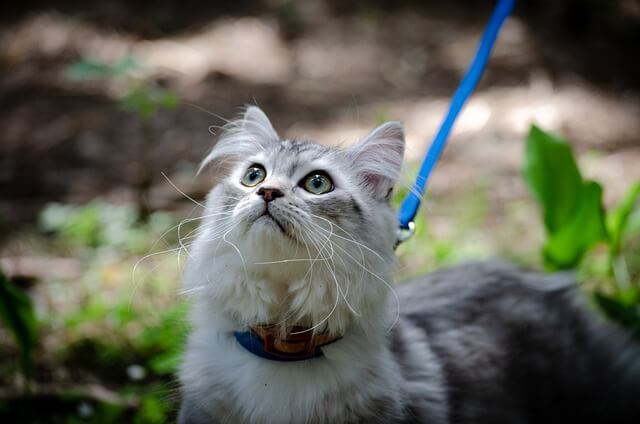How To Teach a Cat To Walk On a Leash? 3 Easy Steps
26.04.2022.
Cats, contrary to popular belief, can be trained to perform tasks that are typically associated with canines. Walking around the block is a favorite pastime for some cats. But, much like a puppy who has never been leash trained, a cat that has never been trained to walk on one will not know what to do.
Why teach a cat to leash walk?
Cats who enjoy exploring the great outdoors and going on walks around the neighborhood need an owner ready to take them there. Your best bet is to teach your cat buddy how to walk nicely on a leash and harness so that your outdoor activities are both safe and fun. The bold and active feline, on the other hand, may easily learn to walk on a leash with these helpful instructions.
Before starting the leash-training
We understand you'd want to have your cat join you in your outdoor adventures as soon as possible, but slow down. There are a few things you have to do before freely walking your little hunter outside safely. Here are a few things you have to think about.
RELATED: How To Train Your Cat: Expert Tips & Tricks
Harness or collar?
There are certain benefits to using collars on cats, such as making them easier to identify and adding a bell. Still, they aren't ideal for leash walking. It is much easier for cats to escape a leash-attached collar because their physique is different than that of dogs. When you're starting the leash training process with your cat, it's considerably safer to do so with a harness.

Select a harness that is snug enough to keep your cat comfortable, but make sure it is not too tight. You can check that by putting two fingers between the cat and the harness, thus ensuring it's not too tight. If there's exactly room for two fingers, the harness is the correct size and tightness. Everything else means it is too tight or too loose.
The best harnesses for cats are those specifically made for them. Your kitten will only concentrate on how hard walking in a harness is if it is uncomfortable. Cats should wear soft-material harnesses designed so the cat can walk naturally. Also, the harness should be light in weight. The D-ring on the back of the harness is for attaching the leash, so be sure it has one there.
RELATED: 5 Tips On How To Bathe A Cat Safely
Picking a leash
Cats can benefit from light, 4 to 6-foot-long leashes for leash training. Once a cat has been trained, retractable and longer leashes can be used, but keep them at a length that allows you to easily control it.
Is your cat protected?
When your cat spends its entire life indoors, you may overlook the dangers it faces from the outside world. It is imperative that all cats receive their required vaccines as well as flea and tick prevention medication on a regular basis. Cats, in particular, are drawn to the outdoors because of the variety of experiences it offers.
Getting started
Once you have selected the perfect and safe gear for your cat and your cat is protected from parasites, you can proceed to the actual training process. Here are the three steps for quick cat leash training.

RELATED: Indoor Vs. Outdoor Cats: Which is Better?
1. Adjustment period
Once your cat feels comfortable wearing the harness, you can move forward with the leash training. You can attach the harness to the leash and see how your cat reacts. Allow your cat enough time to practice being tethered to the leash in the comfort of your own home. Instead of attaching the leash and holding it in place, you should hold the leash in such a way that allows your cat to roam freely. This can be dangerous for certain cats, and you don't want to make your cat afraid of the leash by dragging it around after them. It's time to take your cat outside when it gets comfortable with the leash at home.
2. Yard time
It's time to take your cat outside and let it practice leash walking with you. It's best to let your cat lead at all times and don't rush the process. Allow it to sniff and mark all of the interesting plants it chooses to explore.
SAFETY TIP: When you're near a tree, take extra care! Even when your cat is strapped into a harness, its innate impulse to climb persists. When your cat comes within a few feet of you or comes to you when called, reward it with a favorite goodie.
RELATED: What Is Caterwauling? 5 Most Common Reasons Cats Do It
3. Increasing the distance
You can gradually move to walking down your block if your cat shows that it enjoys its outdoor adventures. Your cat could be satisfied with a leisurely stroll around your yard or perhaps relish the prospect of venturing further. To make sure that it is not stressed and your cat is actually enjoying itself, keep an eye on its body language at all times. 15 minutes of playtime in the fresh air is more than enough for most cats. If you don't want your cat to get too hot or too exhausted, keep an eye on it throughout your walk.
Conclusion
Going for a walk on a leash can be a terrific method to provide your cat with high-quality exercise. However, to make your cat feel comfortable during walkies, you'll have to invest time in leash training. Just remember that positive reinforcement is the most important thing. Cats can be timid creatures, and that's perfectly fine. The greatest approach to this type of training is to ensure it has the time of its life and to let it do anything it wants in the sunshine with you.
World Cat Finder Team







Share